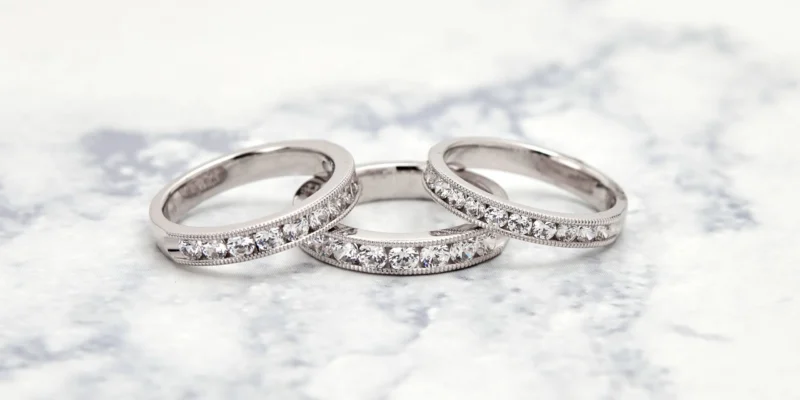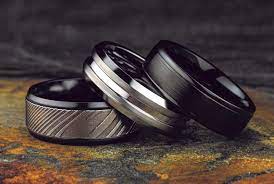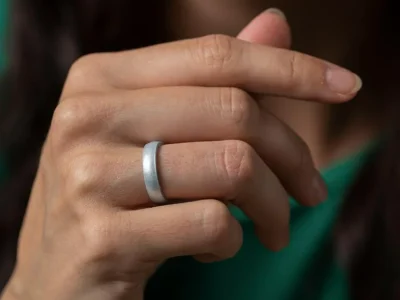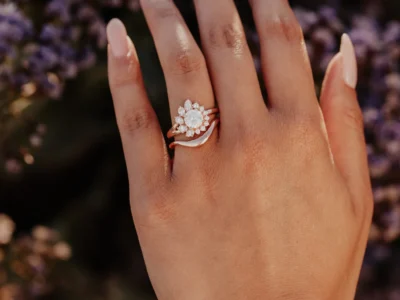When it comes to jewelry showcasing glittering diamonds and gems, selecting the right setting is an art. Prong and channel settings are two common options, each one granting its own appeal and advantages. Discern the contrast between them to make a prudent decision that not only heightens the beauty of your adornment but also guarantees the gems’ security.
Table of Contents
Prong Vs. Channel Setting: Overview
Prong Setting
For precious gems, the prong or claw setting is a favored option, expertly securing stones with delicate metal claws. These curved projections encase the gemstone and let light in to create an incredible sparkle and shine. Notable for adorning engagement rings, wedding bands, as well as other luxe jewelry pieces, this timeless setting ensures that gems stay in place, glittering elegantly and forever.
Advantages of Prong Setting
There are several advantages to choosing a prong setting for your gemstone jewelry:
Maximum Visibility: The prong setting allows for maximum visibility of the gemstone, as the metal prongs hold the stone securely while minimizing the metal’s presence. This setting showcases the beauty of the gemstone and allows light to pass through, enhancing its brilliance.
Versatility: Prong settings are highly versatile and can accommodate various gemstone sizes and shapes. They can be used for round, princess, oval, pear, marquise, and other stone shapes, allowing you to create unique and personalized jewelry pieces.
Easy Cleaning and Maintenance: Prong settings are relatively easy to clean and maintain. The open design of the setting allows for easy access to the gemstone, making it simple to clean any dirt or grime that may accumulate over time.
Cost-Effective: Prong settings are generally more cost-effective compared to other setting styles, making them an attractive option for those with budget constraints. The minimal use of metal in the setting reduces the overall cost of the piece while still providing a secure hold for the gemstone.
Secure Hold: Prong settings offer a secure hold for gemstones, keeping them in place and minimizing the risk of them becoming loose or falling out. The metal prongs are carefully crafted and can provide a firm grip on the stone, ensuring its stability.
Also Read: Emerald Cut vs Princess Cut
Channel Setting
Accented with a timeless grace, the channel setting in jewelry captures the eye – especially in engagement rings and wedding bands. An uninterrupted line of gems are nestled in channels along the metal band without any obstructions or prongs to spoil the continuity. An unobtrusive embrace, the metal cradles each stone in place for a seamless look.
Advantages of Channel Setting
Enhanced Security: The channel setting offers excellent security for gemstones, as the metal edges of the channel hold them securely in place. This setting minimizes the risk of stones becoming loose or falling out.
Protection: The metal edges of the channel provide added protection for the gemstones, reducing the chances of chips, cracks, or scratches. The channel setting is ideal for individuals with an active lifestyle or those who work with their hands.
Sleek and Modern Look: Channel settings create a clean and contemporary aesthetic, with a row of gemstones nestled seamlessly within the band. This setting allows the gemstones to take center stage without the distraction of prongs or metal prongs.
Versatility: Channel settings can accommodate various gemstone shapes and sizes, making them suitable for different jewelry designs. This setting method is commonly used for diamonds, but it can also be used for other precious gemstones.
Low Maintenance: Channel settings are relatively low maintenance compared to other settings, as there are no prongs that need regular checking or tightening. The continuous metal band makes cleaning and care easier.
Prong Vs. Channel Setting: Differences
Cleaning
To maintain its sheen, regular cleaning is necessary for your diamond ring. Prong settings offer an easier and more efficient cleaning than channel settings, making upkeep convenient. Prongs have fewer crevices where dirt and grime can accumulate. Soak the ring in warm soapy water for 20-40 minutes and brush it with a soft bristle toothbrush to bring out its brilliance.
Channel settings need extra attention since they hold the potential of trapping dirt in between small gems. An ultrasonic cleaner should be used cautiously as it may shake loose the diamonds in the channel setting. The best maintenance for this type of setting is to take it to a qualified jeweler who can safely clean it without tampering the stones.
Resizing
The prong setting may be easier to resize than the channel, but demands its own considerations. To reduce the ring’s size, a jeweler must delicately remove the diamond from its prongs before resizing the band. However, restoring a channel setting is far more complex and time-consuming.
A portion of the shank must be severed and rejoined to reduce it in size, while stretching works for minor tweaks. But if a larger size is needed, more drastic measures are necessary. The shank must be severed at several points to accommodate added metal. Incorporating small diamonds into the reconfigured channel adds an additional layer of difficulty as precision is key to protect them. Diamonds embellishing other settings also come with their respective sizing issues which can prove troublesome.
Display
Prongs, despite their flaws, prevail in displaying the center diamond in all its radiance. The arrangement of prongs aims to reveal as much of the diamond as possible, intensifying its shine. High-set prongs raise the diamond above the band, further increasing its luster.
Alternatively, channel settings do not expose the diamond’s sides or pavilion, but still present the table and center stone while accentuating the main diamond with complementary gems. When selecting channel-set diamonds, take caution to ensure high quality for avoidance of a dull effect. However, only colorless diamonds with an outstanding cut should be used for the centerpiece to guarantee its dazzling sparkle.
Variation
A myriad of choices presented themselves in channel and prong settings, unveiling a spectrum of design opportunities. From the diamond cut – be it round, princess or otherwise – to the metal of choice, such as rose gold or platinum, every detail was customizable. Prongs too can be customized, fashioned into unique V-shapes to fit and support emerald and princess cuts securely. All this formed elegant bands, creating beautiful works of art for all occasions.
Snag
The metal prongs of a prong setting can easily become ensnared in clothing and hair, even when they have rounded ends. This tugging force may contribute to the loosening of the prongs, leaving your diamond vulnerable to slipping out. Thus, regularly inspecting and tending to your prong setting is essential to its longevity. In contrast, channel settings provide a protective, snag-free crevice that assure a secure and effortless wearing experience.
Deciding Between Prong and Channel Settings
Prong and channel settings offer two distinct ways to showcase the brilliance of a diamond ring. Prongs allow for increased light entry, amplifying the diamond’s sparkle and commanding attention. Meanwhile, channel settings are ideal for creating an alluring design with a stunning array of accents embedded within the band.
For maximum brightness and impact, consider blending the two styles, with a main diamond held by prongs and accent stones in a channel setting. Whichever option you choose, make sure to reflect your preferences and capture the sentimentality of the moment when crafting your unique ring.







Comments